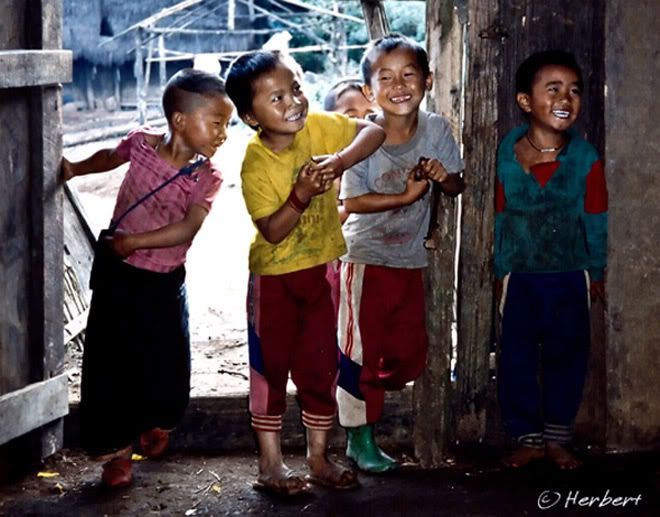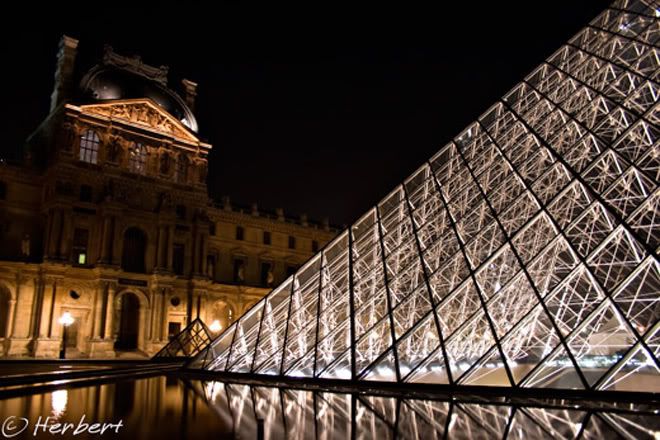February 29, 2008
February 28, 2008
Plant diversity at the Singapore Botanical Garden
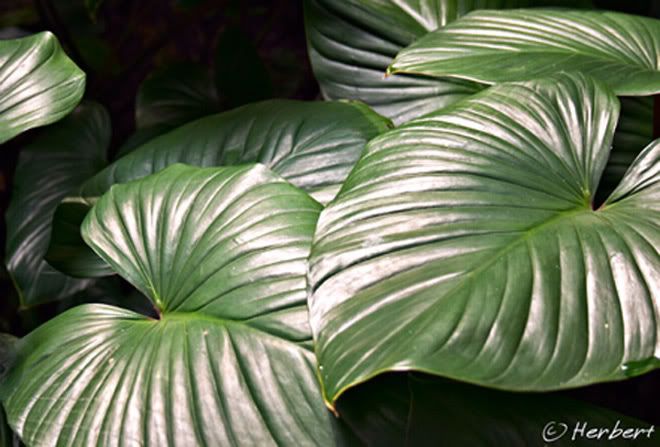
Location: Homalomena rubescens of Araceae family, Singapore Botanical Garden (1°19'18"N 103°48'59"E)
Date: 26 August 200; 10.36am
Camera: Canon 300D with kit kens
Singapore Botanical Garden is a pleasant place to spend a few hours, strolling amongst its vast collection of tropical trees, flowers and plants (see previous post on Singapore guide). It has a fairly substantial collection of plants including about 20,000 orchid plants display in the National Orchid Garden (orchid is Singapore's National Flower). There is even a stage where outdoor performances are held occasionally. Entrance is free except the Orchid Garden.
February 27, 2008
Travelling in South East Asia- Singapore
Singapore is situated right in the centre of South East Asia (SEA) and is a favourite destination for travellers to Asia to stop-over for a few days to enjoy its amenities and to recharge before charging back into the rest of their travelling in Asia.
Singapore is a tiny citystate and is probably only good for 3-5 days of stay at most. This is especially so considering is is quite an expensive destination by Asian standard. But because of its compact size, many places of different themes and interests can be reached rather easily with its efficient transport system compared to most other Asian countries that boast similar but better quality attractions. Most of what one sees in Singapore can be seen in other parts of SEA and in more "original pristine" conditions in those countries. For example guidebooks often rave about Singapore's Chinatown but hey, the whole of Singapore is a Chinatown- one cannot avoid bumping into a Chinese in Singapore every other minute!! It used to be quite quaint with nice old pre-war shophouses but after so many rounds of renovations, demolitions and rebuildings by the government, such shops certainly look overly artificial. The same goes for street market at Bugis Street- miniscule and overpriced compared to the likes in other SEA countries.
However there are a few notable attractions that stand out:
- Orchard Road is definitely worth a visit even though one is not keen to do much shopping but to ogle at the shops and the ladies (and guys). Nearly every major luxury brands in the world are represented here and they are supposedly cheaper than anywhere else in Asia. Serious shoppers can really shop till they are dead- even tourists from all over Asia come to Orchard Road to shop.
- Little India is probably the place with the most Indian-like atmosphere outside of the Indian Sub-continent; especially on a Sunday evening when most of the thousands of South Asian foreign workers in Singapore come out from their workers' enclaves to enjoy their holiday, shopping and meeting with friends.
- Old kampong (village) charms at Pulau (Island) Ubin. This is a small island only few minutes away on a bumboat from Changi Village. It is better to explore this place by cycling (bicycle rental next to the jetty) and finish off with a seafood meal at one of the few old-time coffeeshops on the island.
- Walking in a real primary jungle of undulating trails at the Bukit Timah Nature Reserve. This is one of the best experiences for someone who has not been inside a tropical jungle. Bring insect repellants as the mosquitoes will definitely love you.
- The Botanical Garden is a pleasant place, amongst the flowers and birds. It also has a Rainforest Trail that has remnants of Singapore's original rainforest. One can get close to giant trees, see some colour butterflies and forest birds.
- The Zoo and Night Safari is reputedly the best in Asia and a very worthwhile experience. But beware that the experience will set you back a bit financially.
- Singapore's museums especially the Asian Civilisation Museum is worth a visit. It has good collection and often hold special exhibitions.
On top of such "mainstream" activities, there are also some "hidden" gems that probably only locals will know. Some of these interesting outings would include:
- people watching and getting crowded in at Little India (as above) on a Sunday evening.
- watching street walkers (yes, they are many in this supposedly squeaky-clean state as well) and deals being struck on the narrow lanes between Geylang Lorong 8 and 22 especially along Westerhout Road (only after dark). Also interesting to see how brothels are decorated Singapore-style (from the outside) on these lanes.
- watching beautiful sunsets and the flames from distant oil refineries at Pulau Bukom lighting up the evening sky at Labrador Park.
- sipping ginger tea (teh halia in Malay) and chilling out in the open air along Baghdad Street and puffing shisha in the various cafes along Arab Street in the Kampong Glam area (also known as Arab district).
- sampling local food at a hawker centre or coffeeshop- see this blog for good recommendations.
As alluded before, Singapore is an expensive place and its hotel rates are among the most expensive in SEA. For budget travellers, these are the cheaper but clean, safe and fantastic options- A Travellers Rest Stop (oops- just found out that they have stop operating due to end of lease), Backpacker Cozy Corner Guesthouse and Betel Box Backpackers Hostel. Go to Hangout @ Mount Emily for a slightly pricier option but with more facilities and choice setting (also member of YHA).
February 25, 2008
Yummy kebabs, Kashgar, Xinjiang, China
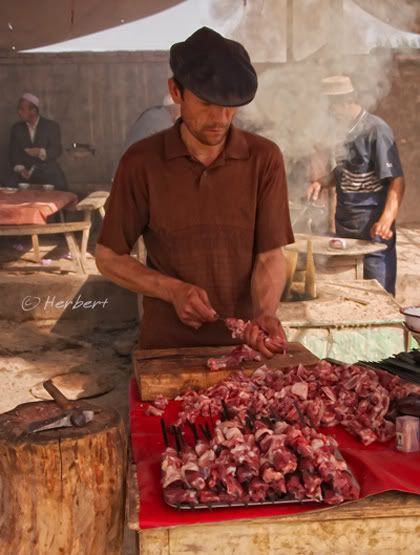
Location: Near Id Kah Square, Kashgar, Xinjiang, China (39°28'13.98"N 75°59'10.62"E)
Date: 29 July 2007; 11.20am
Camera: Canon 400D with Sigma 17-70/f2.8-4.5
Xijiang, the westernmost province of China is also her biggest province. The majority of the province is Uighurs (维吾尔) and nearly all Uighurs are Muslims. They are of Turkic descent and like most Central Asians loves their kebabs. Kebabs can be seen cooked and sold everywhere and anywhere in Uighur areas. It is no different in the ancient oasis city of Kashgar ( 喀什) at the western edge of the massive Taklamakan Desert (second biggest desert in the world). Some Chinese (what do they know about kebabs -wink and smile) claim the best kebabs in China are to be had in this city- I personally tasted better ones at a particular stall in Karghilik or Yecheng ((叶城) a small town 250km south of Kashgar.
February 22, 2008
The Quintessential Hong Kong Skyline
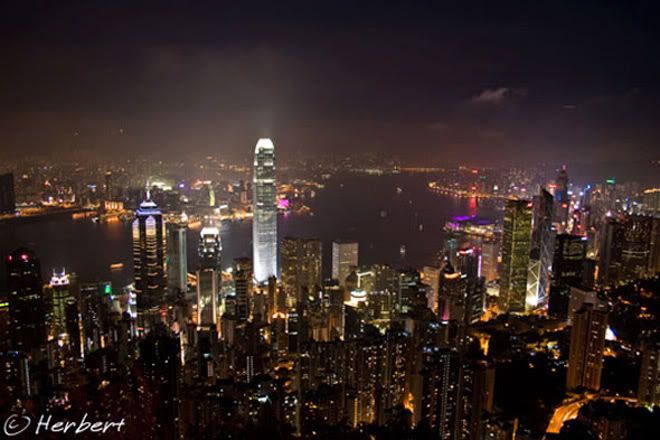 Location: Hong Kong skyline from Victoria Peak (22° 16' 60 N, 114° 9' 0 E)
Location: Hong Kong skyline from Victoria Peak (22° 16' 60 N, 114° 9' 0 E)
Date: 14 November 2004; 6.36pm
Camera: Canon 300D with kit kens
One of the major attractions of Hong Kong is undoubtedly its packed and beautiful skyline. I believed the best place to enjoy that is from Victoria Peak (the Peak). Most people will just take the tram either to the upper Peak Tram station, below and east of the summit and take a few quick photos and peek, then off they go. This is a pity because the best views are actually along a walking circuit that circles the hill. Part of the circuit passes through scrubs and woodland- a bit like a nature trail. A portion of it is built on supports overhanging the side of the hill. One can see different views of the city and harbour along the walk. The easiest way to get on the circuit is to head right along Lugard Road from the Upper Tram station.
Nowadays a view like this photo may be rare as it gets buried under dense blankets of smog drifting from South China.
February 20, 2008
Bolly, Bollywood Fever..........
 Location: A street stall in Kathmandu, Nepal (27°42'26.99"N 85°18'43.60"E)
Location: A street stall in Kathmandu, Nepal (27°42'26.99"N 85°18'43.60"E)
Date: 7 May 2003; 4.00pm
Camera: Canon G1
Every year Bollywood make more movies than Hollywood. Its popularity has spread far and wide in the last few years beyond its traditional markets of Indian Sub-Continent. There are very popular in South East Asia and among the South Asian communities in the West. Bollywood music and dance videos are big hits even in China where the Chinese could not understand a single word muttered. Bollywood stars such as Aishwarya Rai, Hrithik Roshan and Shah Rukh Khan are now probably better known to more people around the globe than Hollywood stars. Their posters and postcards are sold in every other street corner in the streets of Kathmandu (and other South Asian cities).
Technorati Tags: Kathmandu,Nepal,Bollywood
February 18, 2008
Acacia in the Namib Desert
 Location: Near NamibRand Nature Reserve, Namib Desert, Namibia (25° 2'8.68"S 16° 5'41.73"E)
Location: Near NamibRand Nature Reserve, Namib Desert, Namibia (25° 2'8.68"S 16° 5'41.73"E)
Date: 14 April 2001; 4.15pm
Camera: (analogue) Canon 500N with slides and scanned
A huge swath of Namibia is the Namib Desert. Its significance can be gauged from the fact that Namibia's name is derived from the name of the desert. Namib means vast in the local Nama language. It is indeed a vast land of rolling orange dunes, including some of the highest in the world, some 300meters high, around Sossusvlei.
The scenery may be amazing but the local wildlife and flora is just as fascinating. Animals, insects and plants have adapted to this arid and at first sight, inhospitable landscape in distinctly unique, incredible and beautiful fashion. This include the acacia plant photographed here.
February 15, 2008
Dusk at Lake Inle, Myanmar
 Location: Lake Inle at Nyaung Shwe, Myanmar (20°39′N 96°56′E)
Location: Lake Inle at Nyaung Shwe, Myanmar (20°39′N 96°56′E)
Date: 18 December 2000; 7.15pm
Canon EOS 500N (analogue) on slides and scanned
Lake Inle is one of the largest lakes in Myanmar in the Shan State. The majority of the people that lives around the lake are Intha but there are also significant number of Shans, Pa-O's and others.
The lake is quite pretty and is a major tourist destination in Myanmar even though it is the location of much civil and political strife over the last couple of decades, being in the centre of the Shan State.
Major attractions in this area are the huge floating markets and watching the unique rowing style of the men. The rower stands on the stem of the boat with one leg wrapped around the oar, rowing it together with a hand. This rowing style was evolved from the need to stand on the boat to see beyond the reeds and floating plants common on the lake surface.
Travelling in Myanmar is reasonably affordable especially after the military government stopped forcing all foreigners to change US$ for FEC's at ridiculously low rates. However a large swath of the country is still closed to foreigners and its land transport infrastructure is rather ancient. There are domestic flights connecting the major tourist destinations but Myanmar airlines have a rather dismal record on safety.
There is lots of discussion in the travel community on whether one should visit Myanmar considering the brutal repressive nature of the government. The arguments for desisting to visit Myanmar runs on the line that tourists bring in foreign currencies for the government and weakens the boycott on them. Such arguments to me, is invalid because the repressive military government do not rely on tourist dollars to prop them up at all. Their main source of income is from the export of gems, petrol, timber and other natural resources. The only way to force their hand economically is for the major (Western) corporations and neighbouring countries to stop doing business with them. Instead tourism bring in much needed revenue for the Myanmese population. Directly and indirectly this help the livelihood of the repressed people. Furthermore Myanmese themselves want to have more visitors as this gives them a much needed opportunity to interact with the outside world and in the process, impress on outsiders their sufferings and needs. Hence apart from security concerns, I am of the opinion that tourists should continue to visit the country and help the extremely friendly Myanmese population in the process.
February 13, 2008
An Urban Gem at Klang Gates, Kuala Lumpur
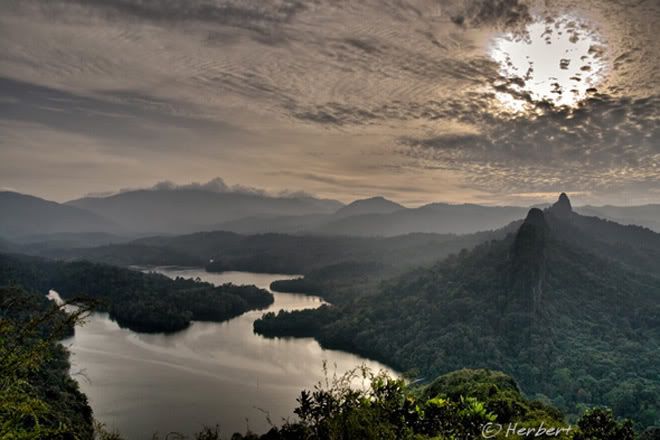
 Location: Bukit Tabur at Klang Gates, Kuala Lumpur, Malaysia (3°14'6.94"N101°44'44.71"E)
Location: Bukit Tabur at Klang Gates, Kuala Lumpur, Malaysia (3°14'6.94"N101°44'44.71"E)
Date: 10 February 2008; 8.42am
Camera: Canon 400D with Sigma 17-70/f2.8-4.5
Bukit Tabur at Ulu Klang, next to the Klang Gates catchment area in Kuala Lumpur is of the most surprisingly fabulous walk in Kuala Lumpur. The line of limestone and quartz ridge consists of nine ridges and is supposedly the longest quartz ridge in Malaysia. It is not high- the highest point is only 448 meters- but it affords a panoramic view of the dam of the catchment area and the skyline of Kuala Lumpur city. The ridges can be seen from many places in the northeast corner outside of KL city. I was told that it is one of the choicest places to watch fireworks over KL.
The starting point of the approximately 2+ hours trek is next to the Klang Gates Dam entrance (see this article for instructions). The "walk" is not exactly a stroll- it involves a fairly steep quick ascend at the start and a series of climbs (though easy) onto rock outcrops. Some of these outcrops are fairly steep and high and permanent ropes are in place to assist trekkers. It can be a little nerving for real starters.
The trail supposedly continues all the way till the other end close to the Karak Highway. However most people loop back after the highest point, following a trail through a durian and rambutan orchard back to the starting point.
February 11, 2008
A Very Cold Bath in Lake Manasarovar, Tibet, China
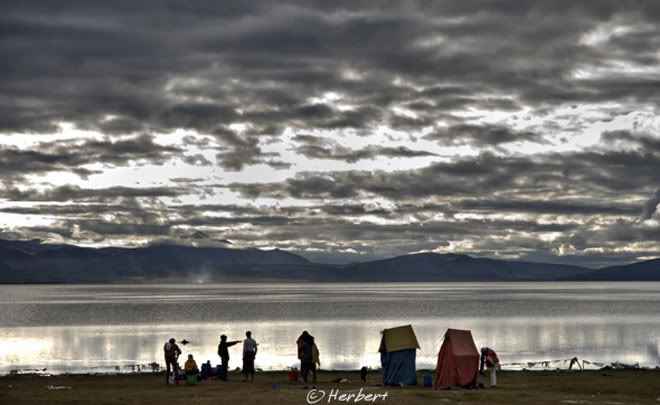 Location: Lake Manasarovar, Ngari Tibet, China (30°40′25.68″N, 81°28′07.90″E)
Location: Lake Manasarovar, Ngari Tibet, China (30°40′25.68″N, 81°28′07.90″E)
Date: 7 August 2007; 9.07am
Camera: Canon 400D with Sigma 17-70/f2.8-4.5
Lake Manasarovar known as Mapham Yutso in Tibetan or 玛旁雍错 in Chinese is situated in one of the remotest parts of the world - at the far western border of Tibet province in China - a region known as Ngari. The region of Ngari borders with India and Nepal. At 4,556m it is the highest freshwater lake in the world. chinabackpacker has a guide on how to get there.
Lake Manasarovar is the source of the mighty Indus River (longest in Pakistan and third longest in the Indian Subcontinent). A few other major rivers such as the Sutlej also trace its source in the vicinity. The lake's water originates from glacier meltwater of the nearby Himalayan mountains.
The lake and the neighbouring Mount Kailash is a major pilgrimage site for many religions. Hindus from India and Nepal and Tibetans make the arduous journey to the lake every year. The Tibetans circumambulate the lake while Hindus take ceremonial baths (as in the picture) and drink the icy cold water of the lake. Such acts are supposed to cleanse believers of their sins.
One Man's Travel Blog: Istanbul....Here I come!!!!!
Barcelona Photoblog: Barcelona City of Angels
Barcelona Photoblog: Barcelona City of Angels
This is a beautifully taken photo- love the saturation. I like your blog- both the layout as well as the insights and perspectives on Barcelona. Thanks.
Travel Photography: Ala Moana beach park, O'ahu
Canadian Travel Writer/Photographer Sailing in the Mediterranean: Lunar eclipse
Canadian Travel Writer/Photographer Sailing in the Mediterranean: Lunar eclipse
Hey, these are very well captured!! Nice orange moon.
February 9, 2008
We are happy to see you - Hmong kids at Mae Sa, Chiengmai
Location: a Hmong village in Mae Sa Valley near Chiengmai, Thailand (18°48'44"N 98°20'1"E)
Date: 26 October 1995; 7.45am
Camera: (analogue) Minolta compact with negatives and scanned
I stayed in a Hmong village in the Mae Sa Valley close to Chiengmai when I did some trekking there many moons ago. These kids from the village were very curious about us and came to see us while we were having breakfast in one of the hut. They must be some of the happiest kids I ever met - just look at their smiles.
The Hmongs are one of the major minorities in Thailand, especially in the north. They are of the same tribe which have been variously known as Mong and Miao. The majority of the Hmongs (or Miaos as is known in Chinese) are to be found in southern China but there are also significant numbers of them in Vietnam (see picture of Flower Hmong girl in an earlier post), Laos and Myanmar.
Technorati Tags: Thailand,Hmong,Chiengmai,Mae Sa
February 6, 2008
Dusk at Maun, Botswana
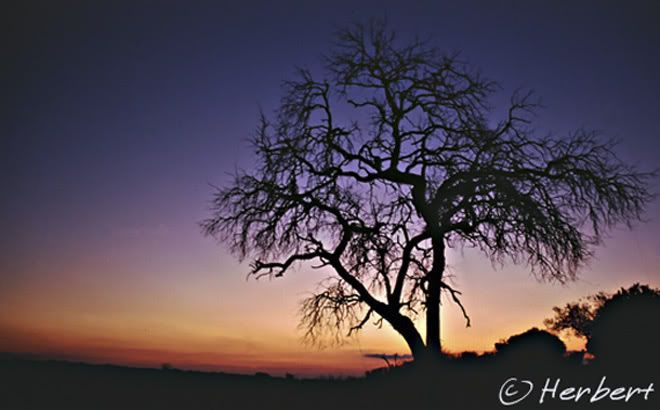 Location: Maun near Okavango Delta, Botswana (19° 58' 60 S,23° 25' 0 E)
Location: Maun near Okavango Delta, Botswana (19° 58' 60 S,23° 25' 0 E)
Date: 22 April 2001; about 7pm
Camera: (analogue) Canon 500N with slides and scanned
Maun is a small town that has become the safari capital of Botswana. The main reason is its proximity to the various camps north of town – Island Safari Lodge, Crocodile Camp and Okavango River Lodge. Sunsets are quite beautiful in this part of Africa.
February 4, 2008
Happy Chinese New Year
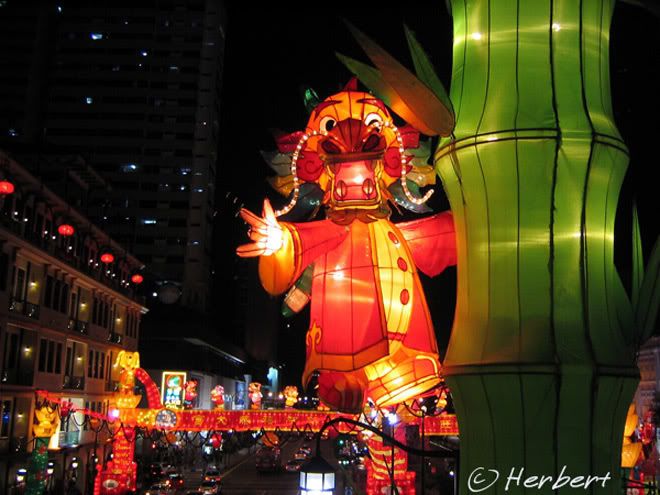 Location: Chinatown, Singapore (1°17'2.30"N,103°50'35.60"E)
Location: Chinatown, Singapore (1°17'2.30"N,103°50'35.60"E)
Date: 16 January 2006; 10.30pm
Camera: Canon IXUS IZoom
Wish my readers a Happy & Prosperous Chinese New Year (CNY).
CNY is the biggest festival on the Chinese calendar and is celebrated by Chinese all over the world. Before CNY the Chinatown areas will be full of temporary street stalls that sell all sorts of goodies and decorations for the new year. The atmosphere is normally very celebratory and the streets are choke-a-block with shoppers. I went to Chinatown to try taking some photos this year but was disappointed with the lights. I thought this photo from a couple of years back was more fun.
February 2, 2008
The merger of classical and ultra-modern architectures - Louvre Museum, Paris
Apart from its immense and excellent collection, the museum is also well-known for its iconic series of glass pyramids, the biggest of which serves as the entrance to the museum. The pyramids, designed by the famous architect, I.M.Pei were controversial right from the start, with such a futuristic edifice seemingly out of place together with the classical French architecture. However it soon earns its place as one of the most recognisable icon of Paris, much like the Eiffel Tower.


















